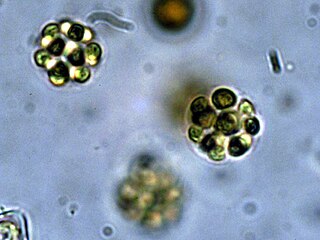
The Chlorophyceae are one of the classes of green algae, distinguished mainly on the basis of ultrastructural morphology. They are usually green due to the dominance of pigments chlorophyll a and chlorophyll b. The chloroplast may be discoid, plate-like, reticulate, cup-shaped, spiral- or ribbon-shaped in different species. Most of the members have one or more storage bodies called pyrenoids located in the chloroplast. Pyrenoids contain protein besides starch. Some green algae may store food in the form of oil droplets. They usually have a cell wall made up of an inner layer of cellulose and outer layer of pectose.

Chlamydomonadales, also known as Volvocales, are an order of flagellated or pseudociliated green algae, specifically of the Chlorophyceae. Chlamydomonadales can form planar or spherical colonies. These vary from Gonium up to Volvox. Each cell has two flagella, and is similar in appearance to Chlamydomonas, with the flagella throughout the colony moving in coordination.

The glaucophytes, also known as glaucocystophytes or glaucocystids, are a small group of unicellular algae found in freshwater and moist terrestrial environments, less common today than they were during the Proterozoic. The stated number of species in the group varies from about 14 to 26. Together with the red algae (Rhodophyta) and the green algae plus land plants, they form the Archaeplastida.

Charales is an order of freshwater green algae in the division Charophyta, class Charophyceae, commonly known as stoneworts. Depending on the treatment of the genus Nitellopsis, living (extant) species are placed into either one family (Characeae) or two. Further families are used for fossil members of the order. Linnaeus established the genus Chara in 1753.
Chlorococcales is a formerly recognized order of green algae in the class Chlorophyceae. As of February 2022, the type family Chlorococcaceae was placed in the order Chlamydomonadales.

AlgaeBase is a global species database of information on all groups of algae, both marine and freshwater, as well as sea-grass.
Pseudochlorella signiensis is a species of green algae in the family Koliellaceae. Pabia signiensis, the only species in the genus Pabia, is regarded as a synonym. Pabia was sunk into Pseudochlorella in 2016.

The Desmidiaceae are one of four families of charophyte green algae in the order Desmidiales (desmids).
Actinochloridaceae is a family of green algae, in the order Chlamydomonadales.
Sykidion is a genus of green algae. Pseudoneochloris is a synonym of this genus. As of March 2022, Sykidion was the only genus in the family Sykidiacaeae, which was the only family in the order Sykidiales.

Chlorokybus is a multicellular (sarcinoid) genus of basal green algae or charophyte. It has been classified as the sole member of the family Chlorokybaceae, which is the sole member of the order Chlorokybales, in turn the sole member of the class Chlorokybophyceae. It grows on soil and rock surfaces, and is rare.
Mesostigma is a genus of unicellular biflagellate freshwater green algae, with a single species Mesostigma viride, covered by an outer layer of basket‐like scales instead of a cell wall. As of February 2022, AlgaeBase classified it as the only genus in the family Mesostigmataceae, the only family in the order Mesostigmatales, the only order in the class Mesostigmatophyceae. It is now considered to be one of the earliest diverging members of green plants/algae (Viridiplantae).
Sycidiales is an order of fossil charophyte green algae. The reproductive structures in Sycidales have a calcified cover, called a utricle, that is thought to prevent the zygote being desiccated. Other Paleozoic families lack this cover, as do modern charophytes. Fossils of the family Sycidiaceae are found over the longest time span, from the Silurian to the Carboniferous.

Sphaerocystidaceae is a family of chlorophyte green algae, in the order Chlamydomonadales.







